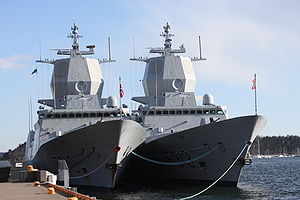HNoMS Helge Ingstad (F313)

Fridtjof Nansen and Helge Ingstad berthed at Oslo, April 2010
|
|
| Class overview | |
|---|---|
| Name: | Fridtjof Nansen class |
| Builders: | Navantia, Ferrol, Spain |
| Operators: |
|
| Preceded by: | Oslo class |
| Completed: | 5 |
| Active: | 5 |
| General characteristics | |
| Type: | Multi-role frigate (Guided missile and ASW) |
| Displacement: | 5,290 tons full load |
| Length: | 134 m (440 ft) |
| Beam: | 16.8 m (55 ft) |
| Draft: | 4.6 m (15 ft) |
| Propulsion: |
|
| Speed: | 27 knots (50 km/h; 31 mph)+ |
| Range: | 4.500 nmi (8.334 km; 5.179 mi) at 16 knots (30 km/h; 18 mph) |
| Complement: | 120, accommodations for 146 |
| Sensors and processing systems: |
|
| Electronic warfare & decoys: |
|
| Armament: |
|
| Aircraft carried: | 1 × NHIndustries NH90 helicopter |
The Fridtjof Nansen-class frigates are a class of frigates that are the main surface combatant units of the Royal Norwegian Navy. The ships are named after famous Norwegian explorers, with the lead ship of the class bearing the name of Fridtjof Nansen, the Norwegian scientist, explorer and humanitarian. Five ships were ordered from Spanish shipbuilder Bazan (now Navantia). As of 2011, all five are in active service. The total projected cost for all five ships is 21 billion kr (about USD 2.5 billion).
The frigates were originally intended as a replacement for the aging Oslo-class frigates, with a primary focus on anti-submarine warfare (ASW). Eventually, the need for a robust anti-aircraft defense as well as the possibility of incorporating the Naval Strike Missile surface-to-surface missile produced by Norwegian company Kongsberg Defence & Aerospace led to a more multi-role design. The selection of Navantia as prime contractor led to the design being very similar to the Spanish Navy's Álvaro de Bazán-class frigates, including the incorporation of Lockheed Martin's AEGIS combat system.
The new frigates are a great improvement over their predecessors, the Oslo-class frigates, not only in size, but also in personnel, capabilities and equipment. Compared to the old Oslo-class vessels, the new ships are 35 meters longer, nine meters taller and two meters deeper below water. They are also five meters broader and have three times the water displacement of the old ships. This solves one of the problems with the Oslo class: lack of space and much discomfort for the crew. The frigates will also operate six new NFH NH90 helicopters, with the role as an extended "arm" of the frigates' ASW and ASuW capabilities.
...
Wikipedia
